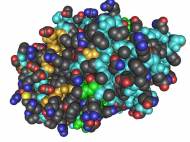Stopping bleeding with nanoscale biological coating
 MIT engineers have developed a nanoscale biological coating that can halt bleeding nearly instantaneously. Although such materials exist for nearly a decade, their success was in creating an easily portable version where thrombin – a clotting agent found in blood – is coated on sponges. The coating could be easily stored and carried for application on the field, making it useful for soldiers or medical personnel.
MIT engineers have developed a nanoscale biological coating that can halt bleeding nearly instantaneously. Although such materials exist for nearly a decade, their success was in creating an easily portable version where thrombin – a clotting agent found in blood – is coated on sponges. The coating could be easily stored and carried for application on the field, making it useful for soldiers or medical personnel.
Traditional methods to prevent bleeding, such as tourniquets, are not suitable for the neck and many other parts of the body. That made researchers to come up with alternative approaches such as fibrin dressings and glues, zeolite powders and bandages made of chitosan, but all of those solutions have flaws that make them unsuitable for fast and effective use on the field.
Led by Paula Hammond, the David H. Koch Professor in Engineering at MIT, the researchers developed a nanoscale biological coating that consists of two alternating layers sprayed onto a suitable material, such as sponge. They discovered that layers of thrombin (a natural clotting protein) and tannic acid (a small molecule found naturally in tea) yield a film containing large amounts of functional thrombin.
Unlike highly absorbent gelatin sponge produced by Ferrosan which needs to be soaked in liquid thrombin just before application to the wound, MIT engineers came up with the idea to coat the sponges with a blood-clotting agent in advance, so they would be instantly ready for use, making them suitable for the use in the field. Once sprayed, the sponges can be stored for months before use. Unlike chitosan which is considered as one of the most effective means used to stop bleeding, the sponges can also be molded to fit the shape of any wound.
“Now we have an alternative that could be used without applying a large amount of pressure and can conform to a variety of wounds, because the sponges are so malleable”, said lead author of the paper Anita Shukla MIT PhD ’11, who is now a postdoc at Rice University.
In experiments where researchers tested how the coated sponges perform once they were applied to wounds, they found out that a coated sponge applied with light pressure (from a human thumb) needed 60 seconds to stop the bleeding. In comparison, sponges lacking thrombin required over 150 seconds to stop the bleeding, and a simple gauze patch wasn’t able to stop the bleeding even after 12 minutes.
The MIT researchers have filed a patent application on this technology and on similar sponges coated with the antibiotic vancomycin, and Hammond group is working on a sponge that could have both blood-clotting and antibiotic properties.
For more information, you can read the full paper published in the journal Advanced Materials: “Hemostatic Multilayer Coatings”.









Leave your response!